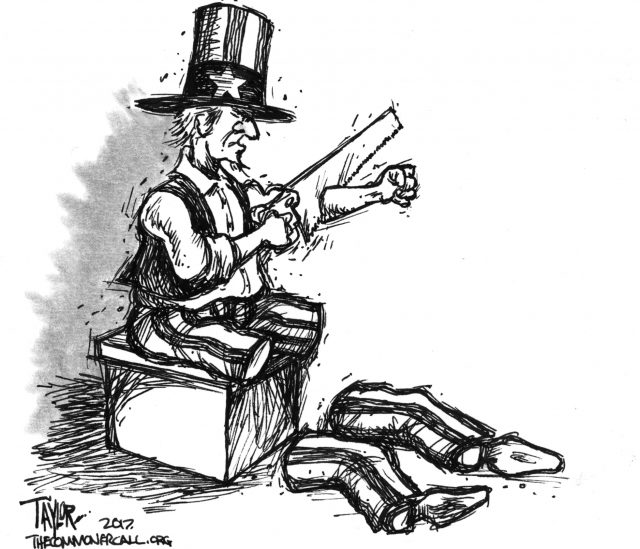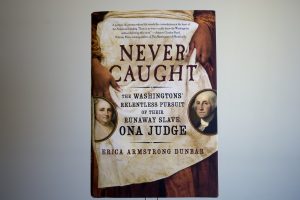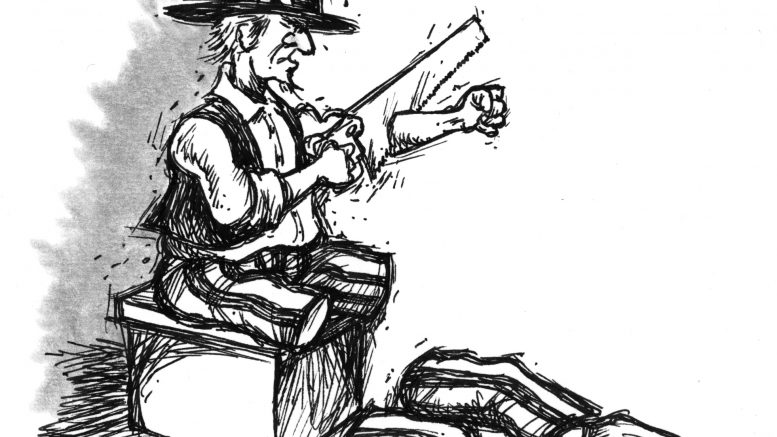
By Chris Hedges
TruthDig (9/24/17)
Historians, like journalists, are in the business of manipulating facts. Some use facts to tell truths, however unpleasant. But many more omit, highlight and at times distort them in ways that sustain national myths and buttress dominant narratives. The failure by most of the United States’ popular historians and the press to tell stories of oppression and the struggles against it, especially by women, people of color, the working class and the poor, has contributed to the sickening triumphalism and chauvinism that are poisoning our society. The historian James W. Loewen, in his book Lies Across America: What Our Historic Markers and Monuments Get Wrong, calls the monuments that celebrate our highly selective and distorted history a “landscape of denial.”
The historian Carl Becker wrote, “History is what the present chooses to remember about the past.” And as a nation founded on the pillars of genocide, slavery, patriarchy, violent repression of popular movements, savage war crimes committed to expand the empire, and capitalist exploitation, we choose to remember very little. This historical amnesia, as James Baldwin never tired of pointing out, is very dangerous. It feeds self-delusion. It severs us from recognition of our propensity for violence. It sees us project on others—almost always the vulnerable—the unacknowledged evil that lies in our past and our hearts. It shuts down the voices of the oppressed, those who can tell us who we are and enable us through self-reflection and self-criticism to become a better people. “History does not merely refer to the past … history is literally present in all we do,” Baldwin wrote.
“If we want to have a public commemoration of history, it ought to be diverse enough to include the whole history, not just the history that those in power want us to remember.” – Historian Eric Foner
If we understood our real past we would see as lunacy Donald Trump’s bombastic assertions that the removal of Confederate statues is an attack on “our history.” Whose history is being attacked? And is it history that is being attacked or the myth disguised as history and perpetuated by white supremacy and capitalism? As the historian Eric Foner points out, “Public monuments are built by those with sufficient power to determine which parts of history are worth commemorating and what vision of history ought to be conveyed.”
The clash between historical myth and historical reality is being played out in the president’s disparaging of black athletes who protest indiscriminate police violence against people of color. “Maybe he should find a country that works better for him,” candidate Trump said of professional quarterback Colin Kaepernick, who knelt during the national anthem at National Football League games to protest police violence. Other NFL players later emulated his protest.
Friday at a political rally in Alabama, Trump bellowed: “Wouldn’t you love to see one of these NFL owners, when somebody disrespects our flag, to say, ‘Get that son of a bitch off the field right now. Out! He’s fired. He’s fired!'” That comment and a Saturday morning tweet by Trump that criticized professional basketball star Stephen Curry, another athlete of African-American descent, prompted a number of prominent sports figures to respond angrily. One addressed the president as “U bum” on Twitter.
The war of words between the president and black athletes is about competing historical narratives. …
(Commoner Call cartoon by Mark L. Taylor, 2017. Open source and free to use with link to www.thecommonercall.org )
*****
The Killing Of History: Another Take On Ken Burns’ Vietnam Series
By John Pilger
CounterPunch (9/22/17)
One of the most hyped “events” of American television, The Vietnam War, has started on the PBS network. The directors are Ken Burns and Lynn Novick. Acclaimed for his documentaries on the Civil War, the Great Depression and the history of jazz, Burns says of his Vietnam films, “They will inspire our country to begin to talk and think about the Vietnam war in an entirely new way”.
In a society often bereft of historical memory and in thrall to the propaganda of its “exceptionalism”, Burns’ “entirely new” Vietnam war is presented as “epic, historic work”. Its lavish advertising campaign promotes its biggest backer, Bank of America, which in 1971 was burned down by students in Santa Barbara, California, as a symbol of the hated war in Vietnam.
Burns says he is grateful to “the entire Bank of America family” which “has long supported our country’s veterans”. Bank of America was a corporate prop to an invasion that killed perhaps as many as four million Vietnamese and ravaged and poisoned a once bountiful land. More than 58,000 American soldiers were killed, and around the same number are estimated to have taken their own lives.
Lack of good faith
I watched the first episode in New York. It leaves you in no doubt of its intentions right from the start. The narrator says the war “was begun in good faith by decent people out of fateful misunderstandings, American overconfidence and Cold War misunderstandings”.
The dishonesty of this statement is not surprising. The cynical fabrication of “false flags” that led to the invasion of Vietnam is a matter of record – the Gulf of Tonkin “incident” in 1964, which Burns promotes as true, was just one. The lies litter a multitude of official documents, notably the Pentagon Papers, which the great whistleblower Daniel Ellsberg released in 1971.
The true scandal is the insidious assumption of power by sinister war-making vested interests for which no American voted.
There was no good faith. The faith was rotten and cancerous. For me – as it must be for many Americans — it is difficult to watch the film’s jumble of “red peril” maps, unexplained interviewees, ineptly cut archive and maudlin American battlefield sequences.
In the series’ press release in Britain — the BBC will show it — there is no mention of Vietnamese dead, only Americans. “We are all searching for some meaning in this terrible tragedy,” Novick is quoted as saying. How very post-modern.
All this will be familiar to those who have observed how the American media and popular culture behemoth has revised and served up the great crime of the second half of the twentieth century: from The Green Berets and The Deer Hunter to Rambo and, in so doing, has legitimised subsequent wars of aggression. The revisionism never stops and the blood never dries. The invader is pitied and purged of guilt, while “searching for some meaning in this terrible tragedy”. Cue Bob Dylan: “Oh, where have you been, my blue-eyed son?”
I thought about the “decency” and “good faith” when recalling my own first experiences as a young reporter in Vietnam: watching hypnotically as the skin fell off Napalmed peasant children like old parchment, and the ladders of bombs that left trees petrified and festooned with human flesh. General William Westmoreland, the American commander, referred to people as “termites”.
In the early 1970s, I went to Quang Ngai province, where in the village of My Lai, between 347 and 500 men, women and infants were murdered by American troops (Burns prefers “killings”). At the time, this was presented as an aberration: an “American tragedy” (Newsweek ). In this one province, it was estimated that 50,000 people had been slaughtered during the era of American “free fire zones”. Mass homicide. This was not news.
To the north, in Quang Tri province, more bombs were dropped than in all of Germany during the Second World War. Since 1975, unexploded ordnance has caused more than 40,000 deaths in mostly “South Vietnam”, the country America claimed to “save” and, with France, conceived as a singularly imperial ruse.
The “meaning” of the Vietnam war is no different from the meaning of the genocidal campaign against the Native Americans, the colonial massacres in the Philippines, the atomic bombings of Japan, the levelling of every city in North Korea. The aim was described by Colonel Edward Lansdale, the famous CIA man on whom Graham Greene based his central character in The Quiet American.
Quoting Robert Taber’s The War of the Flea, Lansdale said, “There is only one means of defeating an insurgent people who will not surrender, and that is extermination. There is only one way to control a territory that harbours resistance, and that is to turn it into a desert.”
Nothing has changed. …
*****
George’s Dark Side: How One Of George Washington’s Slaves Escaped To Freedom

WBUR (3/14/17)
Ona Judge was one of Martha Washington’s slaves who escaped while the Washingtons were living in Philadelphia, the capitol of the young United States at the time. President Washington used the power of the U.S. government to unsuccessfully pursue her capture until the end of his life.
Here & Now‘s Meghna Chakrabarti talks with historian Erica Armstrong Dunbar (@ericaadunbar), author of a new book on Ona Judge, “Never Caught: The Washingtons’ Relentless Pursuit Of Their Runaway Slave, Ona Judge.”

